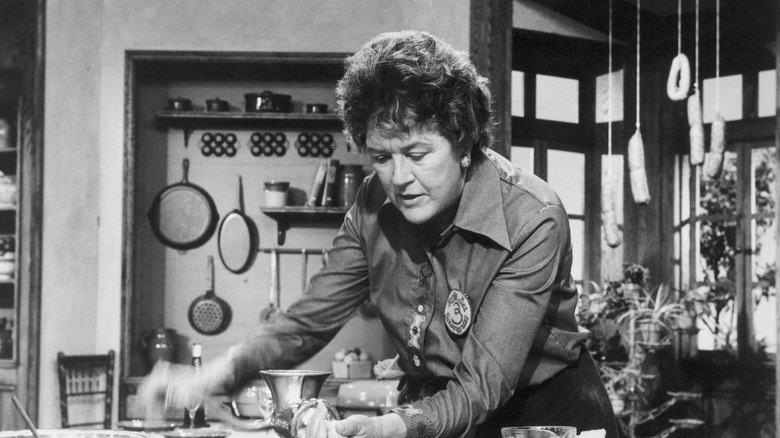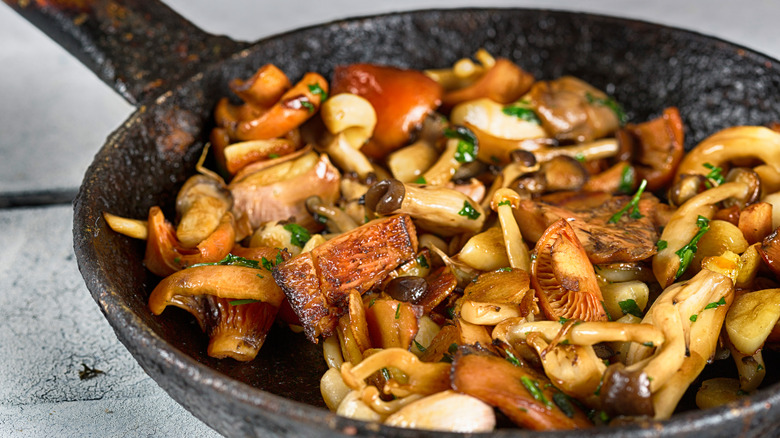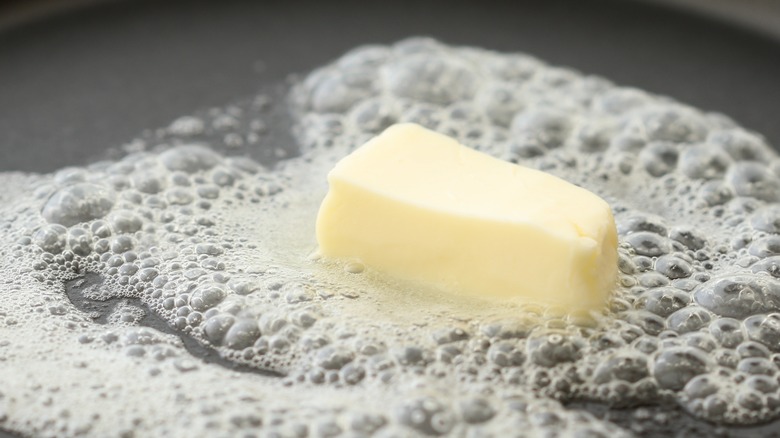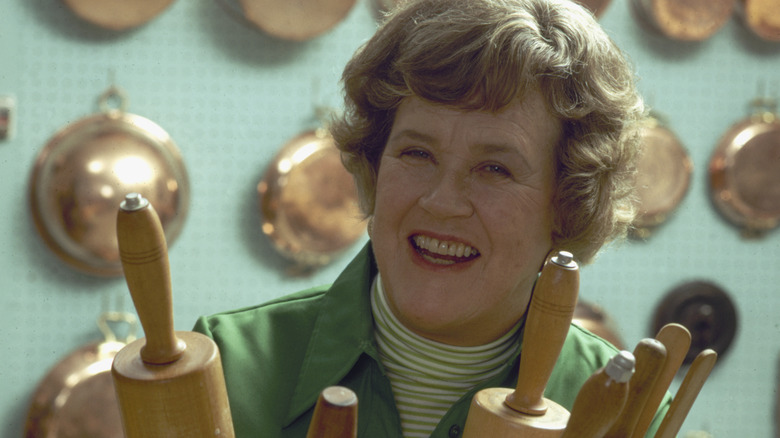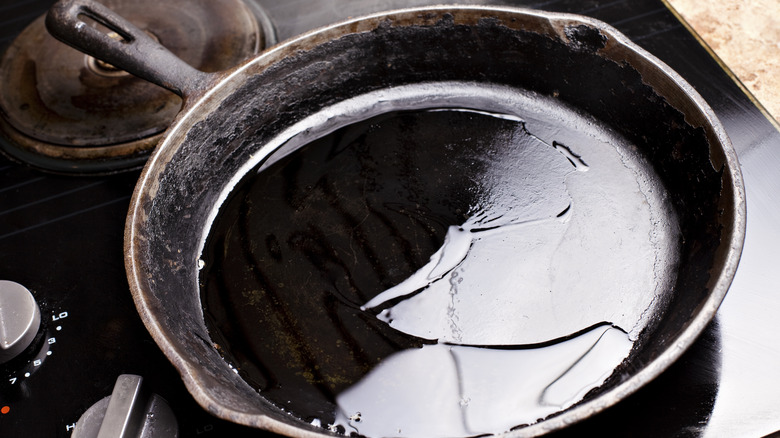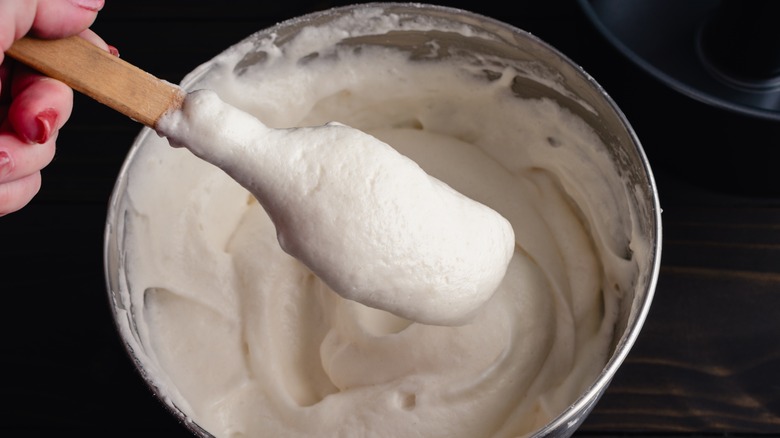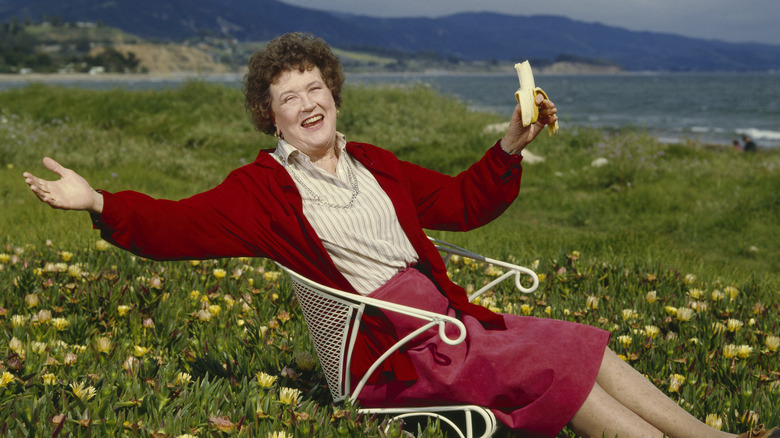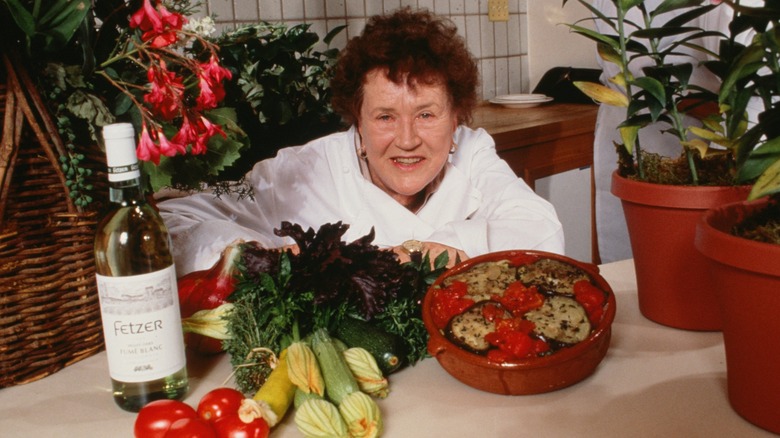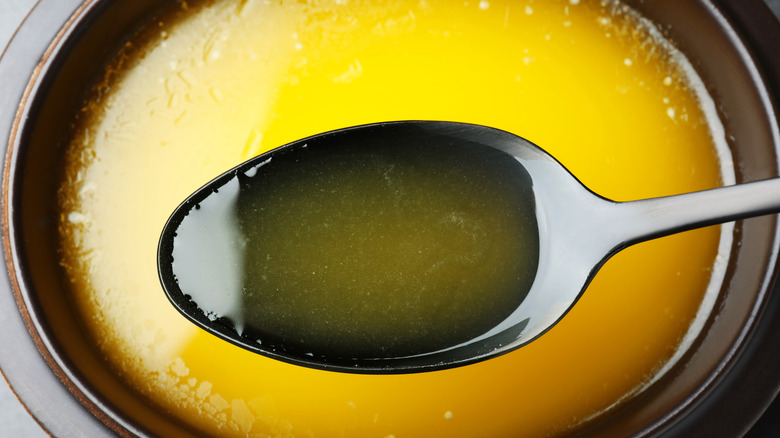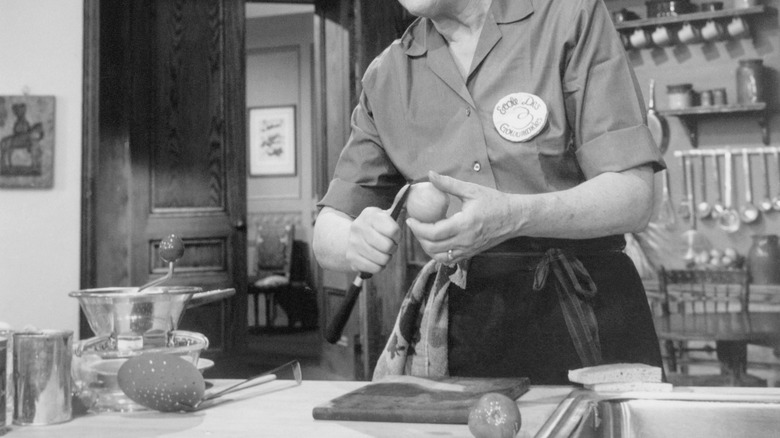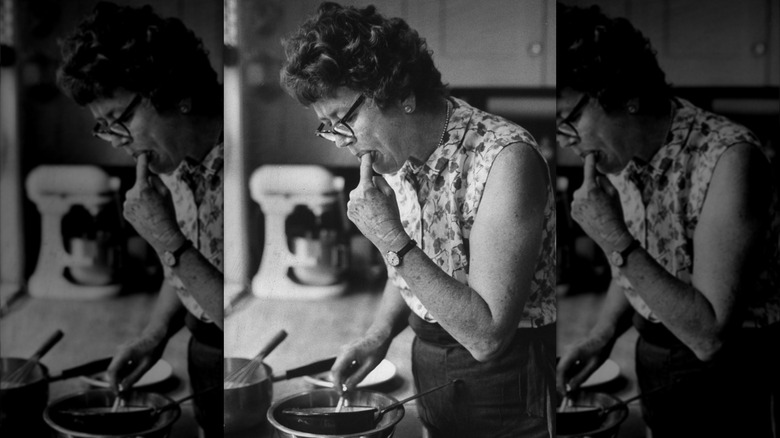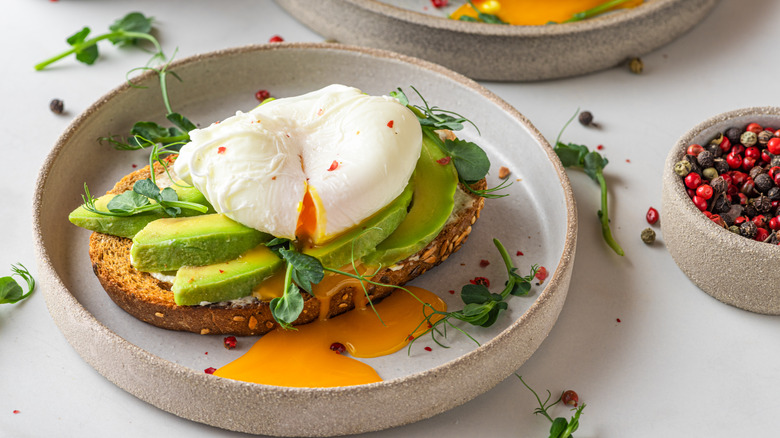Julia Child Cooking Tips That Make Every Meal A Work Of Art
As an American living in France, Julia Child learned the art of French cooking and later brought it to the American public in cookbooks and television shows. She was a beloved figure who made cooking seem easier and more attainable, thanks to her tried-and-true cooking tips. Child studied at the elite cooking school Le Cordon Bleu while living in Paris. But she wanted to show that culinary masterpieces were within reach for those cooking at home as well. She collaborated with culinary educators and writers Simone Beck and Louisette Bertholle to publish the book "Mastering the Art of French Cooking".
Her show, "The French Chef," first premiered in 1963 and ran for 10 years. Each episode, filmed live as she prepared some of her favorite French cuisine, was full of tips that home cooks could use to recreate French food in their own kitchens. Other shows included "Baking with Julia" and "In Julia's Kitchen," which she co-hosted with guest master chefs.
Child became known for her pearls of wisdom that could be applied to numerous dishes as well as her willingness to learn from mistakes without stressing. This was a new way to approach cooking, especially French cooking, which was considered too challenging and complex for novice chefs to attempt. In her lifetime, Child earned Peabody and Emmy awards.
Don't crowd mushrooms in the pan
Julia Child told home cooks to give their mushrooms plenty of space when sautéing. Child hosted an entire episode focused on cooking with mushrooms during season 3 of "The French Chef." In this episode, she showed viewers how to do everything from buying fresh mushrooms, to slicing and dicing them, to preparing them in her favorite dishes. Not overcrowding mushrooms was one of the big takeaways from the episode.
"You want to be sure that your mushrooms are dry and you do not want to crowd your pan," Child told viewers as she placed mushrooms into a sauté pan with butter. Putting too many mushrooms into the pan at once can cause them to steam rather than sauté. Child noted that if you see liquid coming out of the mushrooms as they cook, it is a sure sign that they have steamed and not sautéed, which means they won't have that desirable browning.
Embrace rich ingredients
French cuisine is rich, so it's not surprising that Julia Child advocated for the liberal use of butter or cream in dishes. She often credited butter for making the food taste so delicious. In many episodes of her show, she had a dish of butter on hand to use when sautéing, baking, or cooking. She famously told home chefs that if they were afraid of butter to use cream. Many of her dishes included liberal amounts of both, including butter being used to sauté veggies or sear meats; she added cream to soups and sauces.
When Child was a guest on Martha Stewart's show, she illustrated to viewers how to make rich béarnaise sauce with egg yolk and butter. When making a quiche Lorraine in season 1 of "The French Chef," Child introduced the dish by revealing the crust was made from French dough. "A French dough is made out of butter," she said. "And that's what makes it so good."
Clean as you go and put things away
Julia Child had tips for kitchen efficiency as well as cooking. In "Mastering the Art of French Cooking" she recommended home chefs put used dishes and tools in warm soapy water as they go to make cleanup easier at the end. "Use all the pans, bowls, and equipment you need, but soak them in water as soon as you are through with them," she wrote in the forward of the book. "Clean up after yourself frequently to avoid confusion."
Child also showed viewers how to clean as they cooked, baked, and prepared food during her shows. Because she filmed live, viewers could see how she managed cooking alongside preparation and cleanup in real-time. She filmed "The French Chef" and other cooking shows from her actual kitchen, using tools that she kept on hand to cook for herself and her husband, Paul Child.
An exact replica of her kitchen is on exhibit at the Smithsonian's National Museum of American History. Other than the exterior walls, which were built for the museum in the exact layout of the original kitchen, everything was donated by Child in 2001 to be included in the exhibit. The pegboard wall that holds her pots and pans has an outline of each item, making it easy to put away once finished.
Season your pans
Julia Child demonstrated how to use the right kitchen tools and pointed out features that made them work for a particular dish, such as the size of the pan or the height of the sides. She recommended seasoning a new cast iron skillet before use, which prevents sticking. Nonstick pans were still relatively new at the time and many home cooks may not have had one.
"If you have either an iron pan like this or an aluminum one, you have to season it first before you use it," Child said on the French omelette episode of "The French Chef". "You heat it until it's just a little too warm for your hand." She demonstrated with one of her own seasoned pans. "You pour oil in it and then you let it sit overnight." Then she showed viewers how to coat the bottom with salt, put it over heat, and rub the salt into the pan with a paper towel. Washing the pan with soap would remove the oil and require that you re-season the pan before using it again.
Fold egg whites delicately yet rapidly
Folding adds air to delicate dishes like batter, custard, or meringue. Dishes like cakes and pastries often rely on this technique to get the desired texture. If you don't do it with a light hand, you're likely to beat the batter and egg whites rather than gently fold them together. Fortunately, on the cake for company episode of "The French Chef," Julia Child showed viewers how to fold egg whites into cake batter, a technique that can be applied to other dishes as well. Folding egg whites into pancakes can make them fluffier. The same technique is perfect for everything from a chocolate mousse to an impressive carrot soufflé.
The camera showed an overhead view of Child working with the batter in one bowl and adding the egg whites, one spoonful at a time. She also folded flour into the batter, alternating between the whites and the dry flour. "This is all to be done very rapidly and carefully," she said. "The object is that you do not want to deflate your egg whites because it's the egg whites that make the cake puff up when it gets into the oven."
Don't sweat mistakes
Because Julia Child cooked live on her show, mistakes were bound to happen. But she embraced them as part of the process and encouraged her viewers to do the same. She approached cooking with a smile and a sense of adventure, two things that she thought all chefs needed. "This is my invariable advice to people: Learn how to cook — try new recipes, learn from your mistakes, be fearless, and above all have fun," she said. This attitude became one of the trademarks of her show and celebrity persona. It was also one of the reasons why her show made French cooking seem so attainable for home cooks.
She famously said, "Always remember: If you're alone in the kitchen and you drop the lamb, you can always just pick it up. Who's going to know?" While a guest on "The David Letterman Show" in 1986, Child forgot to check that the burner was working before whipping up a hamburger patty. "This doesn't work at all," she said, the raw hamburger patty sitting in the unheated pan. "So we're going to change this to beef tartare." If you can't laugh while cooking, even while making mistakes, you're missing a big opportunity to have some fun according to Child.
Use fresh ingredients
Julia Child stressed the importance of using fresh, high-quality ingredients whenever possible. "You don't have to cook fancy or complicated masterpieces — just good food from fresh ingredients," she said. In the mushroom episode of "The French Chef," Child showed viewers how to tell the differences between mushrooms at the market, including key markers of freshness.
When she cooked, Child demonstrated why freshness matters with many ingredients. In the poached egg episode, she noted the difference between using a fresh egg and an older one. "If you want to have this lovely shape, you have to have very fresh eggs. Because if you don't have very fresh eggs, you'll end up with a miserable object like this," she said, holding two poached eggs up to the camera. Fresh ingredients will shine brighter in any dish, which means you can keep it simple to achieve delicious meals at home.
Use oil or clarified butter when sautéing
French cooking calls for a lot of sautéing, but it's important to use the right ingredients to keep your cooking fat from burning. Julia Child recommended adding a splash of oil with a high smoke point to help butter along. Butter has a smoke point of around 350 degrees Fahrenheit. Canola oil, on the other hand, has a smoke point of around 400 degrees Fahrenheit. Adding some oil to the melted butter before it gets too hot can keep it from burning.
Clarified butter is another alternative that works when a higher smoke point is needed. Clarified butter has a smoke point of around 450 degrees Fahrenheit, which is why it was the go-to choice for Child in her mushroom episode of "The French Chef," where you can see her spooning clear butter into the pan. Clarified butter doesn't contain milk solids which is why it has a higher smoke point.
Make time for proper prep work
Julia Child prepared her ingredients and tools before starting her dish using the French technique called mise en place, which translates to "everything in its place." The method calls for you to lay out your tools, chop or dice your ingredients, and prepare everything ahead of time so that your attention can remain on cooking and assembling your dish in the moment. As you watch her cook on "The French Chef," you can see that Child never has to reach very far to find the ingredients or tools that she needs. She inspects her tools and ingredients before beginning each dish.
On the roasted chicken episode of "The French Chef," Child had kitchen string, small tools like knives, and her chopped ingredients on a small board to her right while preparing the bird. When it was time to truss the legs, she already had everything ready and was able to do it without stopping. When handling raw meat like chicken, not having to move around the kitchen to grab other tools or ingredients can help prevent cross-contamination.
Test as you go
In all episodes of "The French Chef," viewers can see Julia Child sampling her dishes to find out if she needs to make adjustments. In a video book tutorial on soups, salads, and breads, Child recommended tasting each dish frequently to make sure that you've added the right amount of seasonings. Adjusting cooking times or temperatures can also make a difference. "If you find that it didn't taste [right,] it might need another four or five minutes of simmering," she said. Even when working with other chefs such as Martha Stewart and Jacques Pépin, Child tasted to check on the progress of each dish.
In the cold soufflés and Bavarian cream episode of "The French Chef," Child tested the texture of the egg whites when they formed soft peaks and stiff peaks, adjusting the speed and ingredients at each step. "As soon as they have begun to form soft peaks, then add in that extra tablespoon or two of sugar," she said, holding a scoop of beaten egg whites with her spoon. She turned the mixer back on until they formed stiff peaks. "They're done when they hold themselves like that," she said, again testing the egg whites with her spoon.
Start poached eggs in the shell
Poached eggs can be challenging but Julia Child had a foolproof trick to get the perfect poached egg. To poach an egg, start by pricking it with a pin, then put it carefully into boiling water shell and all, for around 10 seconds. "This firms them up just enough so that when you break them into the water they will hold their shape," Child said during the poached egg episode of "The French Chef".
"Another thing that will help also is to put some vinegar in your water. Put in about two tablespoons of white vinegar per quart of water," Child said. This helps the white coagulate better as the egg poaches. Once you break the egg into the water, use a spatula to push it around to help it keep its shape. After letting the egg cook for four minutes, use a slotted spoon to carefully lift it out of the water for a poached egg that is truly a work of art.
